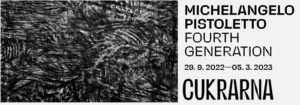Entitled Fourth Generation in reference to the period that crucially determined the artist’s subsequent practice, Michelangelo Pistoletto‘s new exhibition will open on Thursday at 7 pm in Ljubljana. The solo exhibition¹, which will run at the Cukrarna Gallery until 5 March 2023, will be preceded by a press conference scheduled for 29 September at 11 am, an opportunity to highlight the peculiarities of the display in the presence of the artist; Alenka Gregorič, curator and artistic director of the Cukrarna Gallery; Blaž Peršin, director of the Museum and Galleries of Ljubljana public institution; and Dora Stiefelmeier and Mario Pieroni, representing the Zerynthia Association for Contemporary Art in Rome. The exhibition offers a cross-section of the main phases of Pistoletto’s work from the 1960s onwards, with a particular focus on his ‘dark’ period, both in terms of the selection of works and the dramaturgy of the exhibition at the Cukrarna Gallery. The rarely-shown works from those years, which the artist in one of his texts defined Art of Squalour (1985-89), are exhibited on the second floor of the gallery. In addition to drawings, paintings and sculptures, the exhibition includes a 70-metre-long black mural created on site by students of the Ljubljana Academy of Fine Arts under the guidance of the artist. The first floor of the gallery houses a selection of some of Pistoletto’s best-known works: the Mirror Paintings, ranging from a self-portrait from 1961 to more recent additions; the Minus Objects (1965-66), which were the first expressions of Arte Povera; as well as iconic works from this movement, including the Venus of Rags (1967); also featured are the white sculptures from the 1980s. The display concludes with the Third Paradise, which has been the artist’s creative focus since 2003.


“From the art historical point of view, Michelangelo Pistoletto is one of the most prominent representatives of Arte Povera;” the organisers explain, “named by the Italian art theorist, critic, and curator Germano Celant in 1967, Arte Povera originated as an attack on the value paradigms of the political, economic, and art systems of the time, bringing a departure from the use of traditional materials and methods in art”. Pistoletto’s Minus Objects are in fact an early example of the divergence between the production of commercially attractive art objects and the expectations and demands of the art market.
Just a year after the Minus Objects, the artist produced one of his most emblematic works of Arte Povera, the Venus of Rags (1967). “With his projects, intellectual work, and genius for bringing people together,” they add, “Pistoletto has left a highly distinctive mark on both the Italian and international cultural space. In 1998, he started the foundation Cittadellarte in his hometown of Biella. Covering a wide range of activities, Cittadellarte runs an artist-in-residence program and organizes exhibitions and other events, creating a strong bond between art and life by linking the foundation’s activities with what goes on in society.
In his works, Pistoletto wants to engage viewers in direct dialogue with art, actively include us in the compositions, and above all, encourage us to reflect on time – on the time past, represented by the figures on the mirror surfaces, and on the present of our gaze. Functioning like some kind of weightless bodies, the dark surfaces of the drawings, paintings, sculptures, and the wall on the second floor suggest both black infinity and unstoppable motion somewhere beyond it, absorbing light, endlessly distant. The present is captured beyond time, and the space has shrunken, producing a feeling of void. Pistoletto’s exploration of temporality comprises the past caught in the works, the present of the viewer, and our common future augured by the symbol of the Third Paradise”.
Visualizza questo post su Instagram

